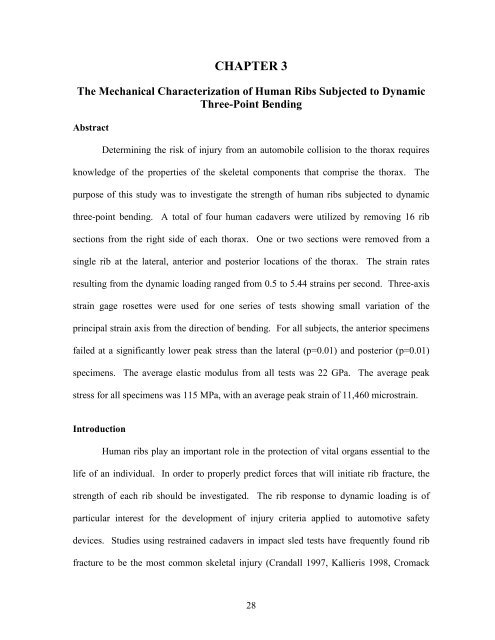Microstructural And Mechanical Properties Of Human Ribs Joseph
Microstructural And Mechanical Properties Of Human Ribs Joseph
Microstructural And Mechanical Properties Of Human Ribs Joseph
You also want an ePaper? Increase the reach of your titles
YUMPU automatically turns print PDFs into web optimized ePapers that Google loves.
CHAPTER 3<br />
The <strong>Mechanical</strong> Characterization of <strong>Human</strong> <strong>Ribs</strong> Subjected to Dynamic<br />
Three-Point Bending<br />
Abstract<br />
Determining the risk of injury from an automobile collision to the thorax requires<br />
knowledge of the properties of the skeletal components that comprise the thorax. The<br />
purpose of this study was to investigate the strength of human ribs subjected to dynamic<br />
three-point bending. A total of four human cadavers were utilized by removing 16 rib<br />
sections from the right side of each thorax. One or two sections were removed from a<br />
single rib at the lateral, anterior and posterior locations of the thorax. The strain rates<br />
resulting from the dynamic loading ranged from 0.5 to 5.44 strains per second. Three-axis<br />
strain gage rosettes were used for one series of tests showing small variation of the<br />
principal strain axis from the direction of bending. For all subjects, the anterior specimens<br />
failed at a significantly lower peak stress than the lateral (p=0.01) and posterior (p=0.01)<br />
specimens. The average elastic modulus from all tests was 22 GPa. The average peak<br />
stress for all specimens was 115 MPa, with an average peak strain of 11,460 microstrain.<br />
Introduction<br />
<strong>Human</strong> ribs play an important role in the protection of vital organs essential to the<br />
life of an individual. In order to properly predict forces that will initiate rib fracture, the<br />
strength of each rib should be investigated. The rib response to dynamic loading is of<br />
particular interest for the development of injury criteria applied to automotive safety<br />
devices. Studies using restrained cadavers in impact sled tests have frequently found rib<br />
fracture to be the most common skeletal injury (Crandall 1997, Kallieris 1998, Cromack<br />
28



